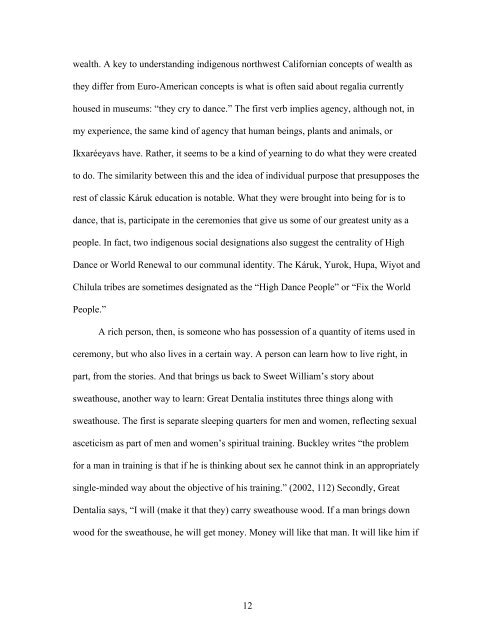The Intersection of Karuk Storytelling and Education
The Intersection of Karuk Storytelling and Education
The Intersection of Karuk Storytelling and Education
You also want an ePaper? Increase the reach of your titles
YUMPU automatically turns print PDFs into web optimized ePapers that Google loves.
wealth. A key to underst<strong>and</strong>ing indigenous northwest Californian concepts <strong>of</strong> wealth as<br />
they differ from Euro-American concepts is what is <strong>of</strong>ten said about regalia currently<br />
housed in museums: “they cry to dance.” <strong>The</strong> first verb implies agency, although not, in<br />
my experience, the same kind <strong>of</strong> agency that human beings, plants <strong>and</strong> animals, or<br />
Ikxaréeyavs have. Rather, it seems to be a kind <strong>of</strong> yearning to do what they were created<br />
to do. <strong>The</strong> similarity between this <strong>and</strong> the idea <strong>of</strong> individual purpose that presupposes the<br />
rest <strong>of</strong> classic Káruk education is notable. What they were brought into being for is to<br />
dance, that is, participate in the ceremonies that give us some <strong>of</strong> our greatest unity as a<br />
people. In fact, two indigenous social designations also suggest the centrality <strong>of</strong> High<br />
Dance or World Renewal to our communal identity. <strong>The</strong> Káruk, Yurok, Hupa, Wiyot <strong>and</strong><br />
Chilula tribes are sometimes designated as the “High Dance People” or “Fix the World<br />
People.”<br />
A rich person, then, is someone who has possession <strong>of</strong> a quantity <strong>of</strong> items used in<br />
ceremony, but who also lives in a certain way. A person can learn how to live right, in<br />
part, from the stories. And that brings us back to Sweet William’s story about<br />
sweathouse, another way to learn: Great Dentalia institutes three things along with<br />
sweathouse. <strong>The</strong> first is separate sleeping quarters for men <strong>and</strong> women, reflecting sexual<br />
asceticism as part <strong>of</strong> men <strong>and</strong> women’s spiritual training. Buckley writes “the problem<br />
for a man in training is that if he is thinking about sex he cannot think in an appropriately<br />
single-minded way about the objective <strong>of</strong> his training.” (2002, 112) Secondly, Great<br />
Dentalia says, “I will (make it that they) carry sweathouse wood. If a man brings down<br />
wood for the sweathouse, he will get money. Money will like that man. It will like him if<br />
12
















